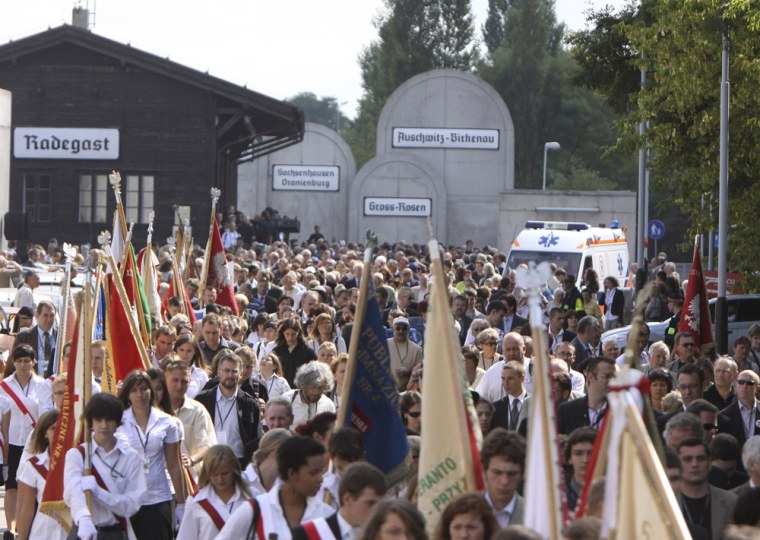Aging Holocaust survivors gathered Thursday to commemorate the 65th anniversary of the last deportations from the Lodz ghetto to Nazi death camps, while Poland's president recalled their suffering and praised the heroism of Poles who risked their lives to save Jews.
Polish President Lech Kaczynski dedicated a memorial — incorporating a Polish eagle into a Star of David — that his office said is the first in the world to commemorate those Polish Christians who rescued their Jewish neighbors during the more than five years of Nazi Germany's occupation of Poland.
Lodz was the second-largest city in prewar Poland, after Warsaw, and home to the second-largest Jewish population, with 231,000 Jews representing more than one-third of the city's population.
"The liquidation of the Lodz ghetto, the murder of some 70,000 people, was the last act in the annihilation of Poland's Jews, who have lived here at least since the 12th century," Kaczynski told a crowd of hundreds, many who had come from as far as Los Angeles, California, and Haifa, Israel.
"Today we honor those who were killed and those who survived and those who — showing the greatest courage — saved their fellow citizens."
Thursday's commemorations began at the aging brown wooden Radegast train station, where about 145,000 Jews began their final journey to Nazi death camps. Wooden cattle cars with flaking rust-colored paint, still stamped with the Nazi-era "Deutsche Reichsbahn," sit in the station as grim reminders of the death trains.
No graves to visit
Kasimira Rosmarinowsky, 86, a survivor who lives in Germany, said she attended the ceremonies to honor her parents and 142 other relatives killed in the Holocaust because she has no graves to visit.
"It's my duty; it's the only thing I can do for my parents," she said.
The survivors, many accompanied by their grown children, then marched 1.5 kilometers (one mile) to Survivor's Park, where the president unveiled the memorial: a concrete eagle, Poland's national symbol, on a pedestal that forms one corner in a giant Star of David. The star's edges are inscribed with the names of the Poles who saved Jews from extermination.
Lodz Mayor Jerzy Kropiwnicki stressed the role played by non-Jewish Poles who hid Jews or smuggled them to safety. He noted that it was not only those caught directly aiding Jews who faced death, but their families as well.
In recent years, Polish officials have sought to commemorate such people as part of an effort led by Kaczynski to dispel the stereotype that Poland was a deeply anti-Semitic country.
Thomas Blatt, 82, a survivor of the Sobibor death camp, said he welcomed efforts to honor such Poles, and considers any person who rescued Jews during the war a "holy man."
"It was really dangerous to do something for Jews, and those who did it are heroes," he said.
‘That's what killed us’
However, Blatt said he would also like to see Poland do more to acknowledge its shameful episodes in the war.
"Unfortunately a lot of Poles collaborated in the case of capturing Jews," he said. "The Germans didn't know who was a Jew or not, but the helpers did know — and that's what killed us."
The Nazis invaded Poland in September 1939. In April of the following year, the Germans sealed the Lodz ghetto with barbed wire, concentrating Jews in a tightly packed section cut off from the outside world.
About 45,000 Jews from other parts of Nazi-occupied Europe, including Luxembourg, Austria and Germany, as well as about 5,000 Gypsies, were forced into the Lodz ghetto. Used as forced labor, many ghetto residents died from the horrific conditions. The Nazis decided to kill those remaining in August 1944.
